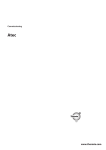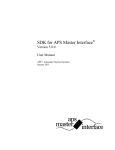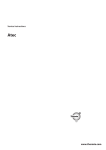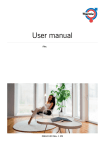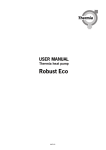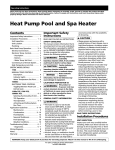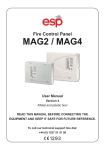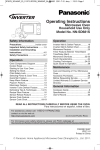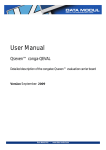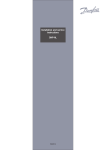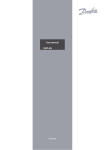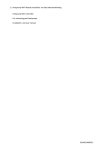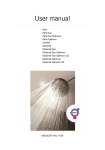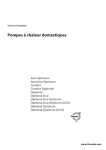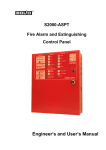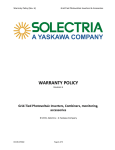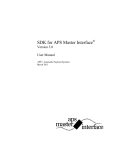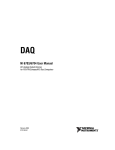Download www.thermia.com
Transcript
Installation Guide Atec www.thermia.com Thermia Värmepumpar is not liable or bound by warranty if these instructions are not adhered to during installation or service. The English language is used for the original instructions. Other languages are a translation of the original instructions. (Directive 2006/42/EC) © Copyright Thermia Värmepumpar Installation Guide Atec Table of Contents 1 About documents and decals . . . . . . . . . . . . . . . . . . . . . . . . . . . . . . . . . . . . . . . . . . . . . . . . . . . . . . . . 1.1 Introduction . . . . . . . . . . . . . . . . . . . . . . . . . . . . . . . . . . . . . . . . . . . . . . . . . . . . . . . . . . . . . . . . 1.2 Symbols in documents . . . . . . . . . . . . . . . . . . . . . . . . . . . . . . . . . . . . . . . . . . . . . . . . . . . . . . . . . . 1.3 Symbols on decals . . . . . . . . . . . . . . . . . . . . . . . . . . . . . . . . . . . . . . . . . . . . . . . . . . . . . . . . . . . . 5 5 5 5 2 Transport, unpacking and setting-up . . . . . . . . . . . . . . . . . . . . . . . . . . . . . . . . . . . . . . . . . . . . . . . . . . . 2.1 Transporting the heat pump . . . . . . . . . . . . . . . . . . . . . . . . . . . . . . . . . . . . . . . . . . . . . . . . . . . . . . 2.2 Unpacking . . . . . . . . . . . . . . . . . . . . . . . . . . . . . . . . . . . . . . . . . . . . . . . . . . . . . . . . . . . . . . . . . 2.3 Positioning the Atec heat pump . . . . . . . . . . . . . . . . . . . . . . . . . . . . . . . . . . . . . . . . . . . . . . . . . . . . 7 7 7 7 3 Heat pump data, dimensions and connections . . . . . . . . . . . . . . . . . . . . . . . . . . . . . . . . . . . . . . . . . . . . 11 4 Piping installation . . . . . . . . . . . . . . . . . . . . . . . . . . . . . . . . . . . . . . . . . . . . . . . . . . . . . . . . . . . . . . . . 4.1 Water volume in heating system . . . . . . . . . . . . . . . . . . . . . . . . . . . . . . . . . . . . . . . . . . . . . . . . . . . 4.2 Minimum flow in the heating system . . . . . . . . . . . . . . . . . . . . . . . . . . . . . . . . . . . . . . . . . . . . . . . . 4.3 Safety valves . . . . . . . . . . . . . . . . . . . . . . . . . . . . . . . . . . . . . . . . . . . . . . . . . . . . . . . . . . . . . . . . 4.4 Connection heating and hot water . . . . . . . . . . . . . . . . . . . . . . . . . . . . . . . . . . . . . . . . . . . . . . . . . . 4.5 Noise information . . . . . . . . . . . . . . . . . . . . . . . . . . . . . . . . . . . . . . . . . . . . . . . . . . . . . . . . . . . . . 13 13 14 14 14 22 5 Electrical Installation . . . . . . . . . . . . . . . . . . . . . . . . . . . . . . . . . . . . . . . . . . . . . . . . . . . . . . . . . . . . . . 5.1 Electrical connection points . . . . . . . . . . . . . . . . . . . . . . . . . . . . . . . . . . . . . . . . . . . . . . . . . . . . . . 5.2 Control centre . . . . . . . . . . . . . . . . . . . . . . . . . . . . . . . . . . . . . . . . . . . . . . . . . . . . . . . . . . . . . . . 5.3 Electrical cabinet in heat pump . . . . . . . . . . . . . . . . . . . . . . . . . . . . . . . . . . . . . . . . . . . . . . . . . . . . 5.4 Cable connection . . . . . . . . . . . . . . . . . . . . . . . . . . . . . . . . . . . . . . . . . . . . . . . . . . . . . . . . . . . . . 5.5 Connecting the outdoor sensor (5) . . . . . . . . . . . . . . . . . . . . . . . . . . . . . . . . . . . . . . . . . . . . . . . . . . 5.6 Connecting supply and return pipe sensors . . . . . . . . . . . . . . . . . . . . . . . . . . . . . . . . . . . . . . . . . . . . 5.7 Connecting supply line sensor distribution circuit 1 . . . . . . . . . . . . . . . . . . . . . . . . . . . . . . . . . . . . . . . 5.8 Connecting sensors to external water heater . . . . . . . . . . . . . . . . . . . . . . . . . . . . . . . . . . . . . . . . . . . 5.9 Connecting room sensor . . . . . . . . . . . . . . . . . . . . . . . . . . . . . . . . . . . . . . . . . . . . . . . . . . . . . . . . 5.10 Connecting system circulation pump . . . . . . . . . . . . . . . . . . . . . . . . . . . . . . . . . . . . . . . . . . . . . . . . 5.11 Connecting circulation pump, distribution circuit 1 . . . . . . . . . . . . . . . . . . . . . . . . . . . . . . . . . . . . . . . 5.12 Connecting heating cable drip tray . . . . . . . . . . . . . . . . . . . . . . . . . . . . . . . . . . . . . . . . . . . . . . . . . . 5.13 Connecting the communication cable . . . . . . . . . . . . . . . . . . . . . . . . . . . . . . . . . . . . . . . . . . . . . . . . 5.14 Connecting the power supply . . . . . . . . . . . . . . . . . . . . . . . . . . . . . . . . . . . . . . . . . . . . . . . . . . . . . 5.15 Connecting the immersion heater cable . . . . . . . . . . . . . . . . . . . . . . . . . . . . . . . . . . . . . . . . . . . . . . 5.16 Connecting the swimming pool sensor . . . . . . . . . . . . . . . . . . . . . . . . . . . . . . . . . . . . . . . . . . . . . . . 5.17 Connecting the distribution circuit 2 sensor . . . . . . . . . . . . . . . . . . . . . . . . . . . . . . . . . . . . . . . . . . . . 23 23 24 25 25 26 26 26 27 27 27 27 28 28 28 29 29 29 6 Menu information . . . . . . . . . . . . . . . . . . . . . . . . . . . . . . . . . . . . . . . . . . . . . . . . . . . . . . . . . . . . . . . . 30 7 INFORMATION menu . . . . . . . . . . . . . . . . . . . . . . . . . . . . . . . . . . . . . . . . . . . . . . . . . . . . . . . . . . . . . . 7.1 Menu overview . . . . . . . . . . . . . . . . . . . . . . . . . . . . . . . . . . . . . . . . . . . . . . . . . . . . . . . . . . . . . . 7.2 Sub-menu OPERAT. . . . . . . . . . . . . . . . . . . . . . . . . . . . . . . . . . . . . . . . . . . . . . . . . . . . . . . . . . . . . 7.3 HEATING . . . . . . . . . . . . . . . . . . . . . . . . . . . . . . . . . . . . . . . . . . . . . . . . . . . . . . . . . . . . . . . . . . . 7.4 DISTRIBUTION CIRCUIT 1 - 2 . . . . . . . . . . . . . . . . . . . . . . . . . . . . . . . . . . . . . . . . . . . . . . . . . . . . . . . 7.5 HOT WATER . . . . . . . . . . . . . . . . . . . . . . . . . . . . . . . . . . . . . . . . . . . . . . . . . . . . . . . . . . . . . . . . . 7.6 COOLING . . . . . . . . . . . . . . . . . . . . . . . . . . . . . . . . . . . . . . . . . . . . . . . . . . . . . . . . . . . . . . . . . . 7.7 POOL . . . . . . . . . . . . . . . . . . . . . . . . . . . . . . . . . . . . . . . . . . . . . . . . . . . . . . . . . . . . . . . . . . . . . 7.8 BUFFER TANK . . . . . . . . . . . . . . . . . . . . . . . . . . . . . . . . . . . . . . . . . . . . . . . . . . . . . . . . . . . . . . . . 7.9 OP. DATA . . . . . . . . . . . . . . . . . . . . . . . . . . . . . . . . . . . . . . . . . . . . . . . . . . . . . . . . . . . . . . . . . . 7.10 OPERAT. TIME . . . . . . . . . . . . . . . . . . . . . . . . . . . . . . . . . . . . . . . . . . . . . . . . . . . . . . . . . . . . . . . 7.11 DEFROST . . . . . . . . . . . . . . . . . . . . . . . . . . . . . . . . . . . . . . . . . . . . . . . . . . . . . . . . . . . . . . . . . . . 7.12 CALENDAR . . . . . . . . . . . . . . . . . . . . . . . . . . . . . . . . . . . . . . . . . . . . . . . . . . . . . . . . . . . . . . . . . 7.13 Sub-menu LANGUAGE . . . . . . . . . . . . . . . . . . . . . . . . . . . . . . . . . . . . . . . . . . . . . . . . . . . . . . . . . . 7.14 ALARM . . . . . . . . . . . . . . . . . . . . . . . . . . . . . . . . . . . . . . . . . . . . . . . . . . . . . . . . . . . . . . . . . . . . 31 31 31 32 32 33 33 33 34 34 35 35 35 36 36 8 SERVICE menu . . . . . . . . . . . . . . . . . . . . . . . . . . . . . . . . . . . . . . . . . . . . . . . . . . . . . . . . . . . . . . . . . . 8.1 Menu overview . . . . . . . . . . . . . . . . . . . . . . . . . . . . . . . . . . . . . . . . . . . . . . . . . . . . . . . . . . . . . . 8.2 HOT WATER . . . . . . . . . . . . . . . . . . . . . . . . . . . . . . . . . . . . . . . . . . . . . . . . . . . . . . . . . . . . . . . . . 8.3 HEATING . . . . . . . . . . . . . . . . . . . . . . . . . . . . . . . . . . . . . . . . . . . . . . . . . . . . . . . . . . . . . . . . . . . 8.4 COOLING . . . . . . . . . . . . . . . . . . . . . . . . . . . . . . . . . . . . . . . . . . . . . . . . . . . . . . . . . . . . . . . . . . 8.5 AUX. HEATER . . . . . . . . . . . . . . . . . . . . . . . . . . . . . . . . . . . . . . . . . . . . . . . . . . . . . . . . . . . . . . . . 8.6 MANUAL TEST . . . . . . . . . . . . . . . . . . . . . . . . . . . . . . . . . . . . . . . . . . . . . . . . . . . . . . . . . . . . . . . 8.7 INSTALLATION . . . . . . . . . . . . . . . . . . . . . . . . . . . . . . . . . . . . . . . . . . . . . . . . . . . . . . . . . . . . . . . 8.8 DEFROST . . . . . . . . . . . . . . . . . . . . . . . . . . . . . . . . . . . . . . . . . . . . . . . . . . . . . . . . . . . . . . . . . . . 37 37 37 38 38 39 39 41 42 Thermia Värmepumpar VMBQY102 3 Installation Guide 9 4 Atec 8.9 OPTIMUM . . . . . . . . . . . . . . . . . . . . . . . . . . . . . . . . . . . . . . . . . . . . . . . . . . . . . . . . . . . . . . . . . . 8.10 BUFFER TANK . . . . . . . . . . . . . . . . . . . . . . . . . . . . . . . . . . . . . . . . . . . . . . . . . . . . . . . . . . . . . . . . 43 43 Important information/Safety regulation . . . . . . . . . . . . . . . . . . . . . . . . . . . . . . . . . . . . . . . . . . . . . . . . 9.1 General safety precautions . . . . . . . . . . . . . . . . . . . . . . . . . . . . . . . . . . . . . . . . . . . . . . . . . . . . . . . 9.2 Refrigerant . . . . . . . . . . . . . . . . . . . . . . . . . . . . . . . . . . . . . . . . . . . . . . . . . . . . . . . . . . . . . . . . . 9.3 Electrical connection . . . . . . . . . . . . . . . . . . . . . . . . . . . . . . . . . . . . . . . . . . . . . . . . . . . . . . . . . . . 9.4 Water quality . . . . . . . . . . . . . . . . . . . . . . . . . . . . . . . . . . . . . . . . . . . . . . . . . . . . . . . . . . . . . . . . 9.5 Commissioning . . . . . . . . . . . . . . . . . . . . . . . . . . . . . . . . . . . . . . . . . . . . . . . . . . . . . . . . . . . . . . 45 45 46 47 47 48 VMBQY102 Thermia Värmepumpar Installation Guide 1 About documents and decals 1.1 Introduction Atec The following documents are available for this product: ▪ The Wiring diagrams that contain the wiring diagram for the heat pump intended for fault tracing and service. The Wiring diagrams are available for download as below. ▪ The User manual must handed over and gone through with the end customer. Supplied with the heat pump on delivery. ▪ Country specific instructions and forms are available where relevant. Supplied with the heat pump on delivery. ▪ Self-adhesive decals with translation text. Must be placed on the manufacturing plate in conjunction with installation. Supplied with the heat pump on delivery. The Service instructions and Wiring diagrams are available for download here: www.thermia.com/documents 1.2 Symbols in documents The instructions contain different warning symbols, which, together with text, indicate to the user that there are risks involved with actions to be taken. The symbols are displayed to the left of the text and three different symbols are used to indicate the degree of danger: Danger Indicates an immediate danger that leads to fatal or serious injury if necessary measures are not taken. Warning Risk of personal injury! Indicates a possible danger that can lead to fatal or serious injury if necessary measures are not taken. Caution Risk of installation damage. Indicates a possible hazard that can lead to item damage if necessary measures are not taken. A fourth symbol is used to give practical information or tips on how to perform a procedure. N 1.3 Information regarding making the handling of the installation easier or a possible operational technical disadvantage. Symbols on decals The following symbols can occur on decals on the different parts of the heat pump. Which symbols are used depends on the heat pump model. Thermia Värmepumpar VMBQY102 5 Installation Guide 1.3.1 ! ! Atec General Warning, danger! Warning, hot surfaces! Read the documentation provided. Warning, moving parts! Read the documentation provided. Warning, risk of crushing injury! Warning, hazardous electrical voltage! 1.3.2 3 50 54 55 71 353 362 304 363 365 366 1.3.3 Electrical components 406 Room sensor Outdoor unit or Outdoor sensor 62 408 EVU 417 Defrost sensor Hot water sensor Hot water top sensor Flow guard Drip tray Explanation Component, ordinary delivery according to proposed system solutions Component, accessorie according to proposed system solutions Shunt valve Circulation pump Exchange valve hot water Supply line sensor Return line sensor Pipe connections Tap water Heating system Brine system Defrosting tank Expansion tank with safety valve, brine Air bleeding Temperature and pressure relief valve Outdoor unit Water heater 6 VMBQY102 Thermia Värmepumpar Installation Guide Atec 2 Transport, unpacking and setting-up 2.1 Transporting the heat pump Caution During transportation or lifting of the entire heat pump, the front panel must always be installed as it locks the other panels construction. Caution The heat pump must always be transported and stored in a dry area. Secure the heat pump so that it cannot tip over during transportation. Caution The heat pump must always be transported and stored standing and in a dry environment. If the heat pump is laid on the incorrect side it may become seriously damaged as the oil in the compressor can run out in the pressure pipe and therefore prevent normal function. When transporting indoors to the installation location it may be necessary to place the heat pump on its back. The time that the heat pump is transported on its back should be as short as possible. After the heat pump has been lifted up again it must stand upright for at least an hour before commissioning. 2.2 Unpacking 2.2.1 Unpack the heat pump 1. Check that there is no transport damage. 2. Remove the packaging. 2.2.2 Delivery check Check that the delivery contains the following components: Quantity 1 1 1 1 2.3 Name Heat pump Control unit Document set Package (1 x shut-off valve with filter, 1 x outdoor sensor) Positioning the Atec heat pump The location of the outdoor unit is chosen so that neither the own living environment or adjoining properties are exposed to noise interference. The device is, to advantage, placed in an environment with lush trees and shrubs with grass surface. Large hard asphalt surfaces and stone or brick walls around the heat pump should be avoided since they effectively reflect the sound. Thermia Värmepumpar VMBQY102 7 Installation Guide Atec Avoid locating the outdoor unit: ▪ close to windows or walls to bedrooms etc. ▪ facing nearby neighbours. ▪ in an inner corner of the building. It gives a very large effect on the direction of sound propagation. N 2.3.1 Adhere to national regulations regarding noise interference. Heat pump foundation 1. The heat pump must be positioned outdoors on a stable base that can take the total weight of the heat pump, see Technical data. 2. Secure all four mounting points on a stable base, for example a cast foundation. 1 4 8 5 a 7 100 mm 2 3 b ~900 mm c Measurements 1 2 3 4 5 6 7 8 6-9 kW 450 mm 424 mm 618 mm 130 mm 61 mm ~1,000 mm ~650 mm Ø 65 mm Position a b c Description Drainage hole Foundation Gravel Bolt size 6-9 kW M10 (4x) 8 6 11-13 kW 470 mm 480 mm 672 mm 190 mm 65 mm ~1,200 mm ~720 mm Ø 65 mm 11-13 kW M12 (4x) VMBQY102 16-18 kW 710 mm 480 mm 857 mm 145 mm 65 mm ~1300 mm ~720 mm Ø 65 mm 16-18 kW M12 (4x) Thermia Värmepumpar Installation Guide Atec Caution A driptray is installed with the purpose of gathering and draining away melt water during defrosting. Connect a hose or pipe along with a heat trace cable between the outlet of the drip tray and a drain or a free draining piece of ground. The heat cable must be connected to the terminal provided and is necessary to prevent ice blockage. Caution Check with a spirit level that the heat pump is installed horizontally. Caution Incorrect positioning of the heat pump risks reduction of performance. Caution The unit with water heater must be placed indoors, in an area with a floor drain. Caution The unit with water heater must be placed indoors, on a stable surface. The floor must be able to support the gross weight of the unit with filled water tank (see Technical data). Avoid placing the heat pump near windows or walls to noise sensitive areas. N Ensure that there is sufficient distance to neighbouring properties so that they are not exposed to noise. Applicable local regulations must be followed. N The heat pump should not be enclosed. N Keep the heat pump and its immediate area free of snow, ice, leaves etc. N Remember that the heat pump must have a certain amount of space in order to function and for servicing. Otherwise there is a risk that the air will recirculate from exhaust to intake. Avoid this by following the dimensions given below. >500 mm N >400 m m m >500 m Thermia Värmepumpar m >5 0 0 m >150 0 mm VMBQY102 9 Installation Guide 2.3.2 Atec Lifting instructions To lift the heat pump into position, unscrew the side plates by slackening off the screws (1). Then use the side members behind the side panels to lift and position the heat pump. 1 10 VMBQY102 Thermia Värmepumpar Installation Guide 3 Atec Heat pump data, dimensions and connections Atec 4 5 3 6 7 2 1 Position 1 2 3 4 5 6 7 Description Width Depth Distance from HP side to supply line pipe Height Height to supply line pipe, 28 mm Cu Height to return line pipe, 28 mm Cu Length max protruding pipe 6-9 kW 856 mm 510 mm 251 mm 1,272 mm 11-13 kW 1,016 mm 564 mm 285 mm 1,477 mm 155.5 mm 96.5 mm 30 mm 16-18 kW 1,166 mm 570 mm 366 mm 1,557 mm Control unit Atec Standard 1. Lead-in for supply, sensor and communication cables 600 1 380 Thermia Värmepumpar 204 VMBQY102 11 Installation Guide Atec Control unit Atec Plus 675 1. 2. 3. 4. 255 420 2 1 Supply line for heating system, 28 mm Cu Supply line to water heater, 28 mm Cu Supply line from heat pump, 28 mm Cu Lead-in for supply, sensor and communication cables 3 4 Control unitAtec Total 1845 ±10 1. 2. 3. 4. 5. 6. 7. 8. 9. 10. Supply line heating system,28 mm Cu Return line heating system,28 mm Cu Connection for bleed valve,22 mm Cu Hot water line,22 mm Cu Cold water line,22 mm Cu Lead-in for supply, sensor and communication cables Supply or return line heat pump Supply or return line heat pump Extra knock-out Safety valve for temperature and pressure (only applies to certain models) Position 7 and 8 can be connected to either the left or right-hand side or at the bottom of the control unit. 330 210 125 7 8 9 690 455 596 2 4 1 12 5 10 3 6 VMBQY102 Thermia Värmepumpar Installation Guide 4 Piping installation Caution Piping installation must be carried out in accordance with applicable local rules and regulations. The hot water tank must be equipped with an approved safety valve. Caution To prevent leaks, ensure that there are no stresses in the connecting pipes! Caution It is important that the heating system is bled after installation. Bleed valves must be installed where necessary. Caution There is a risk of the pipes to the heat pump freezing when water circulation through the heat pump stops when outdoor temperatures fall below freezing. Normally the integrated flow sensor gives an alarm if there is low flow (assumes that there is current to the heat pump), for example when the radiator pump has stopped. In the event of longer flow stops, for example in case of power failure or if the plant is OFF, there is however an obvious risk of freezing . By installing a stop cock on the inside of the house wall it is possible to drain the part of the system that goes out to the heat pump if necessary. Another way of ensuring against freezing is to install an intermediate exchanger indoors. In such cases one must use glycol intended for refrigerant applications in the circuit to the heat pump unit and an extra circulation pump, see System solution intermediate exchanger. Another option is to fill the heating system with antifreeze. Caution Heating systems with closed expansion tanks must also be supplied with approved pressure gauges and safety valves. Caution Cold and hot water pipes and overflow pipes from safety valves must be made of heat resistant and corrosion-resistant material, e.g. copper. The safety valve overflow pipes must have an open connection to the drain and visibly flow into this in a frost-free environment. Caution The connecting pipe between the expansion tank and the safety valve must slope continuously upwards. A continuous upwards slope means that the pipe must not slope downwards from the horizontal at any point. N N 4.1 Atec Ensure that the pipe installation is carried out in accordance with the dimensions and connection diagrams. Configure the heat pump for the desired system solution in the SERVICE\ADD. HEATER\EXTERNAL ADDITION menu. Water volume in heating system In order to secure the defrosting of the outdoor unit, a minimum amount of water must be contained in the heating system. This is shown in the table below. If the heating system itself holds the amount of water described in the table, a volume tank is not needed, but recommended. N Thermia Värmepumpar If the amount of water in the heating system is not sufficient, Low Pressure alarms may occur. VMBQY102 13 Atec Installation Guide Volume tank table Min water volume in heating system. Atec Standard and Atec Plus Min water volume in heating system. Atec Total 4.2 Unit l 6 kW 120 9 kW 180 11 kW 220 13 kW 260 16 kW 320 18 kW 360 l 60 90 110 130 160 180 Minimum flow in the heating system Make sure that the dimensioning of the piping in the heating system is sufficient to get the minimum flow presented below: HP Size l/min N 4.3 6kW 7.9 9kW 11.5 11kW 14.5 13kW 16.7 16kW 19.8 18kW 23.7 Insufficient flow in the system may result in high pressure-, or low heat circulation flow alarms. Safety valves Warning Radiator systems with a closed expansion tank must also be equipped with an approved manometer and safety valve, minimum DN 20, 1.5 bar opening pressure, or according to country specific requirements. Warning Cold and hot water pipes and overflow pipes from safety valves must be made of heat resistant and corrosion-resistant material, e.g. copper. The safety valve overflow pipes must have an open connection to the drain and visibly flow into this in a frost-free environment. Warning The connecting pipe between the expansion tank and the safety valve must slope continuously upwards. A continuous upwards slope means that the pipe must not slope downwards from the horizontal at any point. 4.4 Connection heating and hot water 4.4.1 Connect cold and hot water lines 1. Connect the cold water and hot water pipes with all the necessary components according to the connection diagram for the relevant system. 4.4.2 Connect the heating system supply and return lines For information on how flexible hoses should be installed, see Flexible hoses. 1. Connect the supply pipe with a flexible hose connection and with all the necessary components. 2. Connect the return pipe with a flexible hose connection and with all the necessary components including a filter. 3. Insulate the supply and return lines. 14 VMBQY102 Thermia Värmepumpar Installation Guide N For Atec use the following dimensions for supply and return pipes: 1 2 4.4.3 Atec Supply line 28 mm copper pipe Return line 28 mm copper pipe Atec System solution System solution Atec Standard Atec Standard includes the control module with supply and return line sensors. The heat pump produces only heat or cooling. Two heating circuits can be connected, one using a shunt. The shunt is controlled by the heat pump control system. The flow line temperature is controlled with reference to the outside temperature following a set heat curve. The additional heater starts automatically on demand. Buffer tank is installed for equalisation of the temperature for the heating system and to guarantee sufficient energy when defrosting. The buffer tank volume must be 20 l/kW heat pump output (for systems without water heaters). Atec Standard does not contain a water heater. Water heater is available as an accessory for Atec Plus and is included in Atec Total. For postition explanations, see the chapter Symbol Key. Thermia Värmepumpar VMBQY102 15 Atec Installation Guide 107 108 109 10 21 80 11 10 11 62 80 112 50 51 40 5 36 100 114 355 96 52 91 System solution Atec Plus Atec Plus includes the control module with supply and return pipe sensors, circulation pump, 3-way valve and electric auxiliary heater. The heat pump produces heat, cooling and hot water. Production of heating and hot water cannot occur at the same time because the exchange valve for heating and hot water is positioned after the heat pump and the auxiliary heater. Hot water production is prioritised ahead of heat and cooling. Two heating circuits can be connected, one using a shunt. The shunt is controlled by the heat pump control system. The flow line temperature is controlled with reference to the outside temperature following a set heat curve. The additional heater starts automatically on demand. The auxiliary heater carries out peak heating charging (anti-legionella function) in those operating modes that permit auxiliary heat. Buffer tank is installed for equalisation of the temperature for the heating system and to guarantee sufficient energy when defrosting. The buffer tank volume must be 10 l/kW heat pump output (for systems with water heaters). Water heater is available as an accessory. 16 VMBQY102 Thermia Värmepumpar Atec Installation Guide For postition explanations, see the chapter Symbol Key. 107 108 109 10 11 80 10 11 62 80 112 50 13 85 87 12 83 55 80 77 5 51 40 36 18 114 53 100 355 96 52 91 System solution Atec Total Atec Total includes the control module with supply and return pipe sensors, circulation pump, 3-way valve, electric auxiliary heater and water heater. The heat pump produces heat, cooling and hot water. Production of heating and hot water cannot occur at the same time because the exchange valve for heating and hot water is positioned after the heat pump and the auxiliary heater. Hot water production is prioritised ahead of heat and cooling. Two heating circuits can be connected, one using a shunt. The shunt is controlled by the heat pump control system. The flow line temperature is controlled with reference to the outside temperature following a set heat curve. The additional heater starts automatically on demand. The auxiliary heater carries out peak heating charging (anti-legionella function) in those operating modes that permit auxiliary heat. Thermia Värmepumpar VMBQY102 17 Atec Installation Guide Buffer tank is installed for equalisation of the temperature for the heating system and to guarantee sufficient energy when defrosting. The buffer tank volume must be 10 l/kW heat pump output (for systems with water heaters). For postition explanations, see the chapter Symbol Key. 107 108 109 10 11 80 10 11 62 80 112 50 13 87 55 12 18 77 83 80 40 5 51 36 53 114 100 355 96 52 91 System solution Atec Total with cooling and swimming pool With two distribution circuits and external heater with a shunt. There are two accessories, a cooling system and a swimming pool. For postition explanations, see the chapter Symbol Key. 18 VMBQY102 Thermia Värmepumpar Installation Guide Atec 133 134 135 10 11 63 64 33 10 107 108 109 11 10 117 11 79 83 120 101 112 103 10 11 60 62 80 13 50 87 18 55 12 77 83 80 40 5 51 36 53 114 100 52 355 96 91 Symbol key The following symbol key applies to all system solutions: Pos 5 10 11 12 13 18 21 33 36 40 50 Description Heat pump unit Supply line Return line Cold water Hot water Hot water storage tank Volume tank Circulation pump (shunt additional heater) System circulation pump Control unit Outdoor sensor Thermia Värmepumpar Pos 80 83 85 87 91 96 100 101 103 107 108 Description Shut-off valve Non-return valve Air bleeding valve Safety valve (9 bar, WW) Dirt strainer with shut-off valve Flexible hose Security valve (1.5 bar) Reversing valve pool Pool heater exchanger Shunt valve (distribution circuit 1) Supply line sensor (distribution circuit 1) VMBQY102 19 Installation Guide Pos 51 52 53 55 60 62 63 64 77 79 Atec Description System supply line sensor Return line sensor Hot water starting sensor Hot water sensor top TWC Sensor pool Room sensor Shunt valve (additional heater) Supply line sensor, mixing valve Diverting valve hot water Reversing valve cooling tank Pos 109 112 114 117 120 133 134 135 355 Description Circulation pump (distribution circuit 1) Expansion vessel (hot gas) Immersion heater Additional heater Fan coil Shunt valve (distribution circuit 2) Supply line sensor (distribution circuit 2) Circulation pump (distribution circuit 2) Connecting self-regulating heating cable for drip tray System solution intermediate exchanger To safeguard against the pipes freezing an intermediate exchanger can be installed indoors. In such cases one must use glycol intended for refrigerant applications in the circuit to the heat pump unit and an extra circulation pump. Follow the supplier's instructions for mixing, but if none is given 35% is the lowest concentration recommended. To order and for more information about the intermediate exchanger and the circulation pump, contact Thermia. Caution 20 No glycol mixtures may be used in systems with hot zinc dipped pipes or components. VMBQY102 Thermia Värmepumpar Installation Guide Atec 5 112 65 100 71 Position 5 38 65 71 96 Name Heat pump unit Circulation pump Intermediate exchanger Flow sensor Thermia Värmepumpar 82 38 Position 82 96 100 112 VMBQY102 Name Adjustment valve Flexible hose Safety valve (1.5 bar) Expansion vessel, closed 21 Installation Guide 4.5 Noise information 4.5.1 Installation of the heat pump Atec To prevent disturbing noise from the heat pump the following recommendations should be observed: ▪ In the event the heat pump is positioned on a vibration sensitive base, vibration dampers should be used. The vibration dampers must be correctly dimensioned with regard to the heat pump's weight so that static spring depression of at least 2 mm is obtained in all mounting components. ▪ Connection of the heat transfer fluid to the heat pump must be made using a flexible hose to prevent transmission of vibration to building construction and the pipe system, see Flexible hoses. ▪ Ensure that pipes at lead-ins are not lying against the walls. ▪ Ensure that the electrical supply cable does not provide a path for vibration because it is overstretched. 4.5.2 Flexible hoses All pipes should be routed in such a way that vibrations cannot be transmitted from the heat pump through the piping and out into the building. This also applies to the expansion pipe. We recommend that flexible hoses are used for all pipe connections to avoid the transmission of vibrations. Flexible hoses are available to purchase as accessories. The figures below show how appropriate and inappropriate installations look using this type of hose. 22 VMBQY102 Thermia Värmepumpar Installation Guide 5 5.1 Atec Electrical Installation Danger Electrical voltage! The terminal blocks are live and can be highly dangerous due to the risk of electric shock. All power supplies must be isolated before electrical installation is started. The heat pump is connected internally at the factory, for this reason electrical installation consists mainly of the connection of the power supply. Caution Electrical installation may only be carried out by an authorized electrician and must follow applicable local and national regulations. Caution The electrical installation must be carried out using permanently routed cables. It must be possible to isolate the power supply using an all-pole circuit breaker with a minimum contact gap of 3 mm. (The maximum load for externally connected units is 2A). Electrical connection points This table shows how different electrical equipment should be connected. The positions in the table refers to the system solutions. Pos 5 33 36 40 50 51 52 53 55 60 62 63 64 79 101 107 108 109 114 117 Description Heat pump unit Circulation pump (shunt additional heater) Circulation pump (system) Control unit Outdoor sensor System supply line sensor Return line sensor Hot water starting sensor Hot water sensor top TWC Sensor pool Room sensor Shunt valve (additional heater) Supply line sensor, mixing valve Reversing valve cooling tank Reversing valve pool Shunt valve (distribution circuit 1) Supply line sensor (distribution circuit 1) Circulation pump (distribution circuit 1) Immersion heater Additional heater 120 133 134 135 355 Fan coil Shunt valve (distribution circuit 2) Supply line sensor (distribution circuit 2) Circulation pump (distribution circuit 2) Connecting self-regulating heating cable for draining Thermia Värmepumpar Connect to 101.2 and N 101.1 and N 305 and Com 208.1 and Com DC to 121.1 A to 121.3 Gnd to Gnd B to 121.5 +102.3 -102.4 and N 118.2 and Com M3.3 to L1:1 M3.6 to 101.6 M3.2 to N M3.3 to L1:1 M3.6 to 201.1 M3.2 to N +102.5 - 102.6 and N 118.3 and Com 101.3 and N L1, L2 and N 101.4 and N 230Vac Alternative: Pot free relay max in 250V 8A connect in 101.8 out 101.16 +202.1 - 202.2 and N 208.3 and Com 201.5 and N L1.1, PE and N VMBQY102 23 Installation Guide 5.2 Control centre 5.2.1 Installation Atec The control centre contains the necessary components for voltage supply, control systems and operation. Caution 5.2.2 The control centre must be installed in a frost-free environment. Atec Standard electrical components in the control centre 4 5 3 6 1 Position 1 3 4 5 6 Description Terminal block Hub card Space for expansion card (accessory) Space for communications card (accessory) Space for terminal block for expansion card (accessory) Position 1 2 Description Terminal block Terminal block for internal electrical auxiliary heater (IH) Hub card Space for expansion card (accessory) Space for communications card (accessory) Space for terminal block for expansion card (accessory) Overheating protection Fig. 1: Control unit 5.2.3 Atec Plus electrical components in the control centre 4 7 5 3 2 6 1 3 4 5 6 7 Fig. 2: Control unit 24 VMBQY102 Thermia Värmepumpar Installation Guide 5.2.4 Atec Atec Total electrical components in the control centre 7 Description Terminal block Terminal block for internal electrical auxiliary heater (IH) Hub card Space for expansion card (accessory) Space for communications card (accessory) Space for terminal block for expansion card (accessory) Overheating protection Position 1 2 3 4 5 6 Description Heat pump card Expansion valve card Soft starter Overcurrent protection Terminal block Capacitor (only for 230V 1N) Position 1 2 4 3 7 2 1 5 6 3 4 5 6 Fig. 3: Control unit 5.3 Electrical cabinet in heat pump 2 1 6 3 4 5 Fig. 4: Electrical cabinet 5.4 Cable connection N Laying electrical wiring can also cause noise so this installation must be carried out appropriately. An appropriate installation is where there is approximately 300 mm free cable between the heat pump and the building. It is inappropriate to bolt trunking between the heat pump and the wall. This is because vibrations can then be transmitted from the heat pump through the trunking to the walls of the house. UV resistant cable must be used for outdoor power cables. Cable choice must follow applicable local and national regulations. UV resistant, twinned pair date/telephone cable must be used for outdoor communication cables. The cable must be screened with the one end of the screening (it does not matter which end) earthed in a ground block. The cable section area must be a minimum of 0.25 mm2. When the power cable is connected to the terminal block a screwdriver is used to open the terminal block. Thermia Värmepumpar VMBQY102 25 Installation Guide 2 3 Atec 5 OK! 1 4 1. 2. 3. 4. 5. 6. Insert the screwdriver. Straighten the screwdriver. Push the screwdriver down to release the cable lock. Insert the cable and hold it in place. Pull the screwdriver out. Check that the cable is secured by carefully pulling on the cable. Fig. 5: Connecting power cable to terminal block. 5.5 Connecting the outdoor sensor (5) The outdoor sensor is connected by a two core cable. A maximum cable length of 50 m applies for a cross section of 0.75 mm2. For greater lengths a cross section of 1.5 mm2 is used, up to a maximum of 120 m. Then connect the sensor to the heat pump (outdoors) or the heat pump's control unit (indoors). -B25 50 5 com -B25 50 305 40 com Fig. 6: Connect to the heat pump (outdoor) 5.6 118.5 Fig. 7: Connect to the control unit (indoor) Connecting supply and return pipe sensors Atec Standard - no sensors connected upon delivery. Atec Plus - supply line sensor connected upon delivery. Atec Total - both sensors connected upon delivery. 51 -B8 110 52 -B9 com Fig. 8: Connect supply line sensor 5.7 111 com Fig. 9: Connect return line sensor Connecting supply line sensor distribution circuit 1 108 -B24 118.3 com Fig. 10: Connect supply line sensor distribution circuit 1 26 VMBQY102 Thermia Värmepumpar Installation Guide 5.8 Atec Connecting sensors to external water heater -B20 55 -B21 53 113 114 com com Fig. 11: Connect hot water sensor top 5.9 Fig. 12: Connect hot water sensor start Connecting room sensor -B27 62 DC A GND B 121.1 121.3 121.4 121.5 40 -E3 Fig. 13: Connect room sensor 5.10 Connecting system circulation pump -M4 -M4 101.1 36 36 PE M N -3 116.1 -1 com -4 com -2 116.2 0 - 10 V Fig. 14: Connect system circulation pump Fig. 15: Connect control signal to circulation pump with variable speed 5.11 Connecting circulation pump, distribution circuit 1 -M21 109 M 101.3 102.5 PE 102.6 N N Fig. 16: Connect circulation pump distribution circuit 1 Thermia Värmepumpar 107 Fig. 17: Connect circulation pump distribution circuit 1 230VAC VMBQY102 27 Installation Guide 5.12 Atec Connecting heating cable drip tray R4 L1.1 355 PE N Fig. 18: Connect the electrical drip tray cable 5.13 Connecting the communication cable UV-resistant twisted pair data /telephone cable for outdoor use. Screened cable with the screened connection at the end of the earth terminal. Maximum cable length is 30 metre. 5 com com BUS_B BUS_B BUS_A BUS_A Fig. 19: Connect to the heat pump (outdoor) 5.14 40 Fig. 20: Connect to the control unit (indoor) Connecting the power supply Connect power cable to heat pump unit and to terminal block in control centre as below. Electrical current! The power cable may only be connected to the terminal block intended for this purpose. No other terminal blocks may be used! Danger 2 4 6 1 3 5 L1 L2 L3 N PE 1 L1 SP1 SPARE 5 5 N PE Fig. 21: Connect 400V 3-N 28 2 Fig. 22: Alternative connect 230V 1-N VMBQY102 Thermia Värmepumpar Installation Guide 5.15 Atec Connecting the immersion heater cable L1 114 L2 N PE Fig. 23: Connect immersion heater cable 5.16 Connecting the swimming pool sensor 423 -B28 208.1 60 com Fig. 24: Connect swimming pool sensor 5.17 Connecting the distribution circuit 2 sensor 428 -B29 208.3 134 com Fig. 25: Connect sensor distribution circuit 2 Thermia Värmepumpar VMBQY102 29 Installation Guide 6 Atec Menu information The heat pump has an integrated control system which automatically calculates the heat demand in the house to ensure that the correct amount of heat is produced and emitted when necessary. The control system is operated using a keypad and information is shown in a display and by an indicator. N The information in the display and menus will vary depending heat pump model and connected accessories. ROOM 20°C NO HEAT DEMAND 3 OPERAT. AUTO 1 2 3 Keypad Indicator Display 1 2 30 VMBQY102 Thermia Värmepumpar Installation Guide 7 INFORMATION menu 7.1 Menu overview Atec OPERAT. HEATING DISTRIBUTION CIRCUIT1 DISTRIBUTION CIRCUIT2 HOT WATER COOLING POOL BUFFER TANK OP. DATA OPERAT. TIME DEFROST CALENDAR ▪ CLOCK ▪ HOT WATER ▪ EVU ▪ SILENT MODE ▪ TEMP.REDUCTION ▪ CONCRETE DRYING PROG. ALARM ▪ ▪ LANGUAGE ▪ ▪ ▪ ▪ ▪ ▪ ▪ ▪ ▪ ▪ ▪ ▪ 7.2 Sub-menu OPERAT. Menu selection (OFF) AUTO COMPRESSOR HEAT PUMP AUX. HEATER HOT WATER MANUAL TEST Thermia Värmepumpar Meaning The installation is fully switched off. This mode is also used to acknowledge certain alarms. CANCEL = starting point, no changes made. To select OFF as operating mode, press the minus sign once to scroll down one step and press the right arrow once. Automatic operation with both heat pump and auxiliary heater permitted. If the number of power stages for auxiliary heating are set to zero (SERVICE -> AUX. HEATER -> MAX STEP) only AUTO or OFF can be selected as operating mode. The control system is controlled so that only the heat pump unit (compressor) is allowed to operate. In this operating mode peak heating charging (anti-legionella function) of the hot water will not run because the auxiliary heater is not used. Operation with only compressor permitted. No peak heating charging (anti-legionella function) with only N heat pump operation. Factory setting - Operation with only auxiliary heater permitted. Operation with heat pump for hot water production and auxiliary heater during peak heating charging (anti-legionella function). Only displayed when the value for MANUAL TEST is set to 2 in the SERVICE menu. Outputs that control components are activated manually. - VMBQY102 - - - 31 Installation Guide 7.3 HEATING Parameter CURVE MIN MAX CURVE +5 CURVE 0 CURVE -5 HEAT STOP CONSTANT TEMP SETBACK TEMP ROOM FACTOR 7.4 Atec Meaning Calculated supply temperature at 0°C outdoor temperature. Shown as a graphic curve. The curve will be limited by the set values of MIN and MAX. Factory setting: 40°C (for under floor heating 30°C), range: 22°C – 56°C Minimum permitted supply temperature, if the temperature for heat stop has been reached and the heat pump has stopped. Factory setting: 10°C, range: 10°C – 50°C Maximum calculated setpoint value of the supply temperature. Factory setting: 55°C (for under floor heating 45°C), range: 40°C – 85°C Local increase or reduction of CURVE at an outdoor temperature of +5°C. Shown in the graph for CURVE. Factory setting: 0°C, range: -5°C – 5°C Local increase or reduction of CURVE at an outdoor temperature of 0°C. Shown in the graph for CURVE. Factory setting: 0°C, range: -5°C – 5°C Local increase or reduction of CURVE at an outdoor temperature of -5°C. Shown in the graph for CURVE. Factory setting: 0°C, range: -5°C – 5°C Maximum outdoor temperature when heat production is permitted. If HEAT STOP applies, the outdoor temperature must drop 3°C below the setting before HEAT STOP stops. Factory setting: 17°C, range: 0°C – COOLINGMODE ACTIVE -3°C The temperature that the shunt wishes to retrieve from the buffer tank and distribute to the house. Only applies when the buffer tank is activated and with shunt group connected. Factory setting: 18°C, range: 10°C – 30°C The temperature that will apply at temperature setback. Temperature setback is activated via the calendar function. When the function is activated ROOM is the temperature that is set here. Factory setting: 18°C, range: 10°C – 30°C Only displayed if an accessory Room temperature sensor is installed. Determines how great an impact the room temperature is to have when calculating the supply temperature. For under floor heating it is recommended that ROOM FACTOR is set to 1, 2 or 3. For radiator heating it is recommended that ROOM FACTOR is set to 2, 3 or 4. Impact: 0 = no impact, 4 = large impact. Factory setting: 2, range: 0 – 4 DISTRIBUTION CIRCUIT 1 - 2 Only appears if the function is activated in menu SERVICE -> INSTALLATION - SYSTEM -> SHUNT GROUP. Parameter CURVE MIN MAX CURVE +5 CURVE 0 CURVE -5 DURING COOLING 32 Meaning Calculated supply temperature at 0°C outdoor temperature. Shown as a graphic curve. The curve will be limited by the set values of MIN and MAX. Factory setting: 40°C (for under floor heating 30°C), range: 22°C – 56°C Minimum permitted supply temperature, if the temperature for heat stop has been reached and the heat pump has stopped. Factory setting: 10°C, range: 10°C – 50°C Maximum calculated setpoint value of the supply temperature. Factory setting: 55°C (for under floor heating 45°C), range: 15°C – 70°C Local increase or reduction of CURVE at an outdoor temperature of +5°C. Shown in the graph for CURVE. Factory setting: 0°C, range: -5°C – 5°C Local increase or reduction of CURVE at an outdoor temperature of 0°C. Shown in the graph for CURVE. Factory setting: 0°C, range: -5°C – 5°C Local increase or reduction of CURVE at an outdoor temperature of -5°C. Shown in the graph for CURVE. Factory setting: 0°C, range: -5°C – 5°C During production of cooling the shunt group can be adjusted. Factory setting: AUTO, range: AUTO, OPEN, CLOSED VMBQY102 Thermia Värmepumpar Installation Guide Parameter CONSTANT TEMP SETBACK TEMP 7.5 Atec Meaning Controlling the shunt group against a constant temperature is an alternative to the control using a heat curve given above. Control using constant temperature is selected using the parameter CONSTANT TEMP in the Service menu. Factory setting: 18°C, range: 10°C – 30°C The temperature the shunt group works with when the temperature reduction is activated in the menu CALENDAR. Factory setting: 18°C, range: 10°C – 30°C HOT WATER Parameter HOT WATER Meaning Allows hot water production. Factory setting: , range: – ON TOP-UP Forced hot water production with compressor and aux. heater. Factory setting: , range: – ON 7.6 COOLING Parameter COOLING Meaning Allows production of cooling. Factory setting: , range: – ON START Temperature on the return sensor for start of cooling production. Factory setting: 25°C, range: STOP + 5°C – MAX START TEMP Temperature on the supply line sensor for stop of cooling production. Factory setting: 16°C, range: MIN STOP – START - 5°C With stated or higher outdoor temperatures cooling production is permitted. Factory setting: 25°C, range: HEAT STOP + 3°C – 50°C STOP COOLINGMODE ACTIVE 7.7 POOL Only appears if the function is activated in menu SERVICE -> INSTALLATION - SYSTEM -> POOL. Parameter POOL TEMP Meaning Temperature from separate pool sensor where the heat production for the pool is stopped. Factory setting: 20°C, range: , 5°C – 40°C POOL HYSTERESIS When the temperature in the pool falls below the value of POOL TEMP minus the value of POOL HYSTERES the production of heating for the pool is started. Factory setting: 2°C, range: 1°C – 10°C Thermia Värmepumpar VMBQY102 33 Installation Guide 7.8 Atec BUFFER TANK The menu only appears if the function is activated in menu SERVICE -> INSTALLATION - SYSTEM -> BUFFER TANK. Parameter TANK TEMP OVERCHARGE TOPH. TANK RED. TANK TEMP 7.9 The function permits a reduction of the temperature in the tank when the temperature reduction is set to active in the CALENDAR menu. The temperature that is set in the tank is calculated by the system when the function has been activated. The function is only active at CONFIGURATION = TANK CONTROL and all configured circuits are set to shunt at constant temperatures. Factory setting: , range: – ON OP. DATA Parameter OUTD ROOM SUPPLY LINE RETURN LINE SYSTEM SUPPLY DISTRIBUTION CIRCUIT 1 DISTRIBUTION CIRCUIT 2 BUFFER TANK HOT WATER INTEGRAL REFR 1 REFR 2 POOL CURRENT DISCH. PIPE SUCTION GAS EVAP. PRESSURE DEFR SENSOR 34 Meaning Indicates desired temperature for buffer tank. The temperature is controlled dependent on the selection made in the Service menu. Standard setting is AUTO if at least one circuit is set to be controlled by the option HEAT CURVE IN SERVICE -> BUFFER TANK, and that all configured circuits out from the tank are shunted (i.e. not open circuits). AUTO means that the temperature in the tank follows the settings for the heat curve. At CONFIGURATION = TANK CONTROL and all configured circuits are set to shunt at constant temperatures, the lowest of the temperatures calculated by the system as a standard setting is set. AUTO mode is not available in this selection. Factory setting: AUTO, range: AUTO, 20°C – 55°C The temperature of the buffer tank can be raised so that it exceeds the heat curve temperature. Can only be used when TANK TEMP = AUTO. Factory setting: 0°C, range: 0°C – 5°C Activate high temperature mode when the external auxiliary heater is selected. The external auxiliary heater will heat the tank to the highest permitted tank temperature. Factory setting: , range: – ON Meaning Shows the temperature on the outdoor sensor. Shows the temperature on the room sensor. Shows the temperature on the supply line sensor. The calculated supply temperature to the heating system group is within brackets. Shows the temperature on the return line sensor. The stop temperature, MAX RETURN is within brackets. Displays the temperature of the system supply line sensor at the buffer tank system or if the external auxiliary heater is activated. Shows the temperature on the distr. cir. 1 sensor. The calculated supply temperature for the shunt group is within brackets. Shows the temperature on the distr. cir. 2 sensor. The calculated supply temperature for the shunt group is within brackets. Shows the temperature on the sensor for the buffer tank. Displays the temperature on the hot water sensor on the condition that hot water production is permitted. Shows the actual calculated value for the integral. Shows the temperature at refrigerant sensor 1. Shows the temperature at refrigerant sensor 2. Displays the temperature on the pool sensor on the condition that pool operation is permitted. Displays the current consumption in Amperes. The set value for MAX CURRENT is shown in brackets. Only appears if CURRENT LIMITER is selected in the Service menu. Shows the temperature at the discharge pipe sensor. Shows the temperature of the suction gas. Shows the pressure of the suction gas pipe. Measured in bar atmospheric pressure, bar (a). Shows the temperature of the defrost sensor. VMBQY102 Thermia Värmepumpar Installation Guide 7.10 OPERAT. TIME Parameter COMPRESSOR COMPRESSOR SL HEATING COOLING HOT WATER AUX. HEAT 1 AUX. HEAT 2 AUX. HEAT 3 EXT.AUX.HEATER 7.11 Meaning Operating time for compressor. Operating time for compressor SLAVE. Operating time for heating. Operating time for cooling. Operating time for hot water with compressor. OPERAT. TIME AUX. HEATER 1. OPERAT. TIME AUX. HEATER 2. OPERAT. TIME AUX. HEATER 3. Operating time external auxiliary heater. DEFROST Parameter DEFROSTS BETW. 2 DEFR TIME LAST DEFR DEFROST CURVE MANUAL DEFR 7.12 Atec Meaning Total number of defrosts carried out. The operating time of the compressor in minutes between the two last defrosts. The operating time of the compressor in minutes since last defrost. Used to change the angle of the defrost curve using + or – (Change the start temperature for defrost). Factory setting: -7°C, range: -10°C – -4°C Used to perform a manual defrost. Started using + or -. Factory setting: 0, range: 0 – 1 CALENDAR Parameter CLOCK HOT WATER EVU SILENT MODE TEMP. REDUCTION CONCRETE DRYING PROG. Thermia Värmepumpar Meaning Indicate day's date and time. Used in the calendar function and in the log at the alarm. DATE: day-month-year, example: 01-jan-2011 CLOCK: hours:minutes, example: 20:30 To block hot water production. Up to eight calendar settings can be defined. Under CALENDAR SETTING, first select the menu TIME FUNCTION if blocking should be over a continuous time period (DATE) or be recurring (DAYS / WEEK). Then start and stop times are selected in the TIME SETTING menu. EVU stops the heat pump and is a function that is used in certain countries to control electrical consumption. Up to eight calendar settings can be defined Under CALENDAR SETTING, first select the menu TIME FUNCTION if stop should be over a continuous time period (DATE) or be recurring (DAYS / WEEK). Then start and stop times are selected in the TIME SETTING menu. Function where the noise level of the heat pump fan is reduced. Up to eight calendar settings can be defined. Under CALENDAR SETTING first select the menu TIME FUNCTION if reduction should be over a continuous time period (DATE) or be recurring (DAYS / WEEK). Then start and stop times are selected in the TIME SETTING menu. Function for reduction of temperatures. The new setpoints are those values that are stated for heat curve, shunt groups and buffer tank in the information menu. Up to eight calendar settings can be defined. Under CALENDAR SETTING first select the menu TIME FUNCTION if reduction should be over a continuous time period (DATE) or be recurring (DAYS / WEEK). Then start and stop times are selected in the TIME SETTING menu. See description in the section Concrete drying. VMBQY102 35 Installation Guide 7.13 Atec Sub-menu LANGUAGE Menu selection SVENSKA ENGLISH DEUTSCH NEDERLANDS FRANÇAIS ESPAÑOL ITALIANO NORSK DANSK SUOMI EESTI POLSKI ČEŠTINA 7.14 ALARM Parameter NAME ALARM 36 Meaning Displays information about up to 10 alarms and alarm times. NAME: Name of the alarm, example: AUX. HEATER TIME: hours:minutes, example 20:45 DATE: day-month-year, example 13-jan-11 VMBQY102 Thermia Värmepumpar Installation Guide 8 SERVICE menu 8.1 Menu overview N Atec To be able to chose a specific function, the sensor for that function must be connected. HOT WATER HEATING COOLING AUX. HEATER MANUAL TEST INSTALLATION ▪ SYSTEM ▪ HEAT SOURCE ▪ POOL ▪ DISTRIBUTION CIRCUIT 1-2 ▪ BUFFER TANK ▪ OPTIMUM ▪ CURRENT LIMITER ▪ START UP CHECK SERVICE TIME ▪ FACTORY SET ▪ RESET OPER. TIME ▪ ▪ SENSOR CALIBRATION ▪ VERSION ▪ LOG TIME ▪ DEFROST ▪ OPTIMUM ▪ BUFFER TANK ▪ ▪ ▪ ▪ ▪ ▪ 8.2 HOT WATER Parameter START Meaning Start temperature for hot water production. Shows the actual weighted hot water temperature and the value within brackets indicates the start temperature. ( = no hot water production) Factory setting: 40°C, range: HOT WATER TIME TOPH. INTERVAL , 30°C – 55°C Time for hot water production during combined hot water demand and heating or cooling demand, in minutes. Factory setting: 20M, range: 5M – 40M Time interval between peak heating chargings (anti-legionella function) in days. Operating mode that permits auxiliary heater must be selected. Factory setting: 7D, (range: , 1D – 90D TOPH. TIME Time in hours that the legionella demand is to be fulfilled for peak heating charging to be considered complete. Factory setting: , range: , 1H – 10H TOPH. STOP Stop temperature for peak heat charging. Operating mode that permits auxiliary heater must be selected. Factory setting: 60°C, range: 50°C – 65°C Hot water sensor’s influence compared with the peak sensor’s at start of water heating. Factory setting: 65%, range: 0% – 100% INFL. H.W SENSOR. Thermia Värmepumpar VMBQY102 37 Installation Guide Parameter TOPH SENSOR HOT WATER SENSOR 8.3 HEATING TIME HYSTERESIS MAX RETURN START INTERVAL OUTDOOR STOP FACTOR HP RS HYST.LOW RS HYST.HIGH Meaning The integral’s value (in degree minutes) for starting the heat pump. See Integral for more information. Factory setting: -60 min, range: -250°min – -5°min When the heat pump must alternate between different demands for example heating, hot water, pool heating and cooling, heating will be produced longest according to the set number of minutes. Factory setting: 20M, range: 5M – 40M If the difference between the actual supply temperature and the calculated supply temperature is too great either the integral value is set to start value A1 (the heat pump starts) or the value is set to 0 (stops the heat pump). Factory setting: 12°C, range: 1°C – 15°C Stop temperature at high return from the heating system. Factory setting: 55°C, range: 30°C – 70°C Minimum time interval between two heat pump starts in minutes. Factory setting: 20M, range: 10M – 30M Lowest outdoor temperature when the outdoor sensor stops the compressor and heating or hot water are instead produced by the auxiliary heater. Operating mode that permits auxiliary heater must be selected. Factory setting: -20°C, range: -20°C – -1°C Activation of room sensor function for blocking or resetting of the integral calculation. Factory setting: , range: – ON Integral calculation is blocked if the temperature of the room sensor exceeds the setpoint value minus RS HYST.LOW. Factory setting: 1°C, range: 0°C, 5°C – 5°C Integral calculation is reset and the heat pump stops if the temperature of the room sensor exceeds the setpoint value plus RS HYST.HIGH. Factory setting: 1°C, range: 0°C – 5°C COOLING Parameter COOLING Meaning Activates the cooling function. Factory setting: , range: , ACTIVE COOLING, INTEGRATED IN HP COOLING TIME When the heat pump must alternate between different demands for example heating, hot water, pool heating and cooling, cooling will be produced longest according to the set number of minutes. Factory setting: 20M, range: 5M – 40M Highest settable temperature for START parameter in INFORMATION -> COOLING. Factory setting: 30°C, range: COOLING->START – 55°C Lowest settable temperature for STOP parameter in INFORMATION -> COOLING. Factory setting: 16°C, range: 5°C – COOLING->STOP Activation of room sensor function for influencing cooling production. Factory setting: , range: – ON MAX START TEMP MIN STOP TEMP ROOM SENSOR COOL.HYST.RS LOW COOL.HYST.RS HIGH 38 Meaning Shows the actual temperature at the top of the water heater provided that this sensor is engaged. Shows the actual temperature approx 1/3 from the bottom of the hot water sensor. HEATING Parameter INTEGRAL A1 8.4 Atec Compressor is stopped if the temperature from the room sensors falls below the desired temperature minus COOL.HYST.RS LOW Compressor is not permitted to start if the criteria are not met. VMBQY102 Thermia Värmepumpar Installation Guide 8.5 Atec AUX. HEATER Parameter MAX STEP Meaning Maximum number of permitted steps for auxiliary heating. = no auxiliary heating permitted (Means that only AUTO, HEAT PUMP or [SYMBOL] can be selected and that no anti-legionella operation is possible.) P = the potential free output controls an immersion heater connected before the hot water reversing valve and not an external auxiliary heater as normal. Factory setting: , range: , – 5, P INTEGRAL A2 Two conditions must be fulfilled in order to start the auxiliary heater: the integral’s value to start must be less than integral A2, and the supply temperature must be 2°C lower than the calculated temperature. See Integral for more information. Factory setting: -600°min, range: -990°min – A1 - 10°min If the difference between the actual supply temperature and the calculated supply temperature is too great (see Important parameters), either the integral value is set to start value A2 (starts the auxiliary heater) or to 0 (stops the auxiliary heater ). Factory setting: 20°C, range: 5°C – 30°C Refers to main fuse in the unit, in amperes. An expansion card must be connected for current measurement. Factory setting: 20A, range: 16A – 35A Stop temperature for hot water during AUX. HEATER. The value is read off by the hot water sensor. Factory setting: 60°C, range: 50°C – 65°C Gives the time that the start of the auxiliary heater is delayed after a temperature reduction or EVU stop. Factory setting: 30M, range: 0M – 120M Activates the function for external auxiliary heater and states how it should be configured. EXT.AUX.HEATER: Switch the external auxiliary heater off and on. Factory setting: , range: – ON HYSTERESIS MAX CURRENT HOT WATER STOP START DELAY EXT.AUX.HEATER INTEGRAL A3: Indicates the value of the integral when external auxiliary heater is connected. Factory setting: -300, range: -990 – A1 - 10°min TURN OFF DELAY: Indicates how long the external auxiliary heater must continue to be active after its demand is no longer needed. Factory setting: 0M, range: 0M – 180M REV.V. HOT WATER: Indicates whether the reversing valve for hot water is located before or after the external auxiliary heater. (Determines whether the external auxiliary heater may produce hot water. Factory setting: INT, range: INT – EXT TOPH. EXT. Indicates whether the external auxiliary heater can be used for anti-legionella. The reversing valve must be positioned after the external auxiliary heater. Factory setting: , range: – ON SHUNTTIME EXT.: Indicates the shortest permitted interval between control signals to the shunt. Factory setting: 60S, range: 10S – 99S 8.6 MANUAL TEST Parameter MANUAL TEST COMPRESSOR Thermia Värmepumpar Meaning 0 = deactivate manual test 1 = activate manual test 2 = activate manual test with option of navigating from the SERVICE menu to check that the temperatures rise for example. 0 = stop compressor 1 = start compressor VMBQY102 39 Installation Guide Atec Parameter CIRC. PUMP SYSTEM CIRC. PUMP Meaning 0 = stop circulation pump system 1 = start circulation pump system 0-10V for test of speed controlled circulation pump. Depending on type and number of connected circulation pumps, this parameter will contain different information. In the event of pumps with fixed speed, the selection 0 = stop and 1 = start are available FAN 0–10V for test of the speed controlled fan FOUR-WAY VALVE 0 = four way valve is set for heating 1 = four way valve is set for defrosting/cooling EXPANSION VALVE 0 – 100% for test of electronic expansion valve. SOLENOID 0 = closed solenoid 1 = open solenoid COMPR.HE 0 = compressor heater off 1 = compressor heater on DRIP TRAY 0 = drip tray heater off 1 = drip tray heater on REV.V. HOT WATER 0 = reversing valve in heating mode 1 = reversing valve in hot water mode AUX. HEAT 1 0 = stop of internal immersion heater power stage 1 1 = start of internal immersion heater power stage 1 AUX. HEAT 2 0 = stop of internal immersion heater power stage 2 1 = start of internal immersion heater power stage 2 AUX. HEAT 3 0 = stop of internal immersion heater power stage 3 1 = start of internal immersion heater power stage 3 EXT.AUX.HEATER 0 = stop external heat source (230V) 1 = start external heat source (230V) POT.FREE 0 = potential free output for control of auxiliary heater open 1 = potential free output for control of auxiliary heater closed CIRC. PUMP DiCi.1 0 = stop circulation pump in discharge circuit 1 1 = start circulation pump in discharge circuit 1 SHUNT DiCi.1 – = closes shunt in discharge circuit 1 0 = shunt unaffected + = opens shunt in discharge circuit 1 CIRC. PUMP DiCi.2 0 = stop circulation pump in discharge circuit 2 1 = start circulation pump in discharge circuit 2 SHUNT DiCi.2 – = closes shunt in discharge circuit 2 0 = shunt unaffected + = opens shunt in discharge circuit 2 SYSTEM SHUNT – = closes shunt 0 = shunt unaffected + = opens shunt RET.LINE HP – = closes return line shunt in systems with buffer tank SHUNT 0 = shunt unaffected + = opens shunt in systems with buffer tank REV. V. POOL 0 = reversing valve in normal mode 1 = reversing valve in pool mode ALARM 0 = no voltage on output 201.6 External alarm 1 = 230V on output 201.6 External alarm DIGITAL OUT 0 = no voltage on output 204.1 1 = 5V (2mA) on output 204.1 40 VMBQY102 Thermia Värmepumpar Installation Guide 8.7 Atec INSTALLATION Parameter HEAT SOURCE POOL DISTRIBUTION CIRCUIT 1 - 2 BUFFER TANK Meaning Selecting heat pump type for configuration of control. Outdoor air with direct evaporation and four-way valve. Activates the pool function. Factory setting: , range: – ON Activates the shunt group function and indicates if the shunt group is to be controlled by the heat curve or by a constant temperature. Factory setting: , range: – HEAT CURVE – CONSTANT TEMP SHUNT TIME - Indicates the shortest permitted interval between control signals to the shunt. Factory setting: 60S, range: 10S – 99S Activates the buffer tank function. Factory setting: , range: – ON OPTIMUM Activates the Optimum function, makes use of a speed controlled circulation pump possible. Factory setting: , range: – ON CURRENT LIMITER Activates the current limiting function. An expansion card must be installed for current measurement. Factory setting: , range: – ON START UP CHECK Activation of the function for checking temperature and pressure at compressor start.If deviations are found this is indicated by an alarm. Factory setting: ON, range: – ON SERVICE TIME N FACTORY SET RESET OPER. TIME SENSOR CALIBRATION Only used for test operation. The heat pump counts 60 times as fast, which means that the waiting times are eliminated during test operation. 0 = deactivates SERVICE TIME 1 = activates SERVICE TIME, which speeds up the control system’s integral calculation and start delay by 60 times. Factory setting: 0, range 0 – 1 Indicates if resetting to factory settings must be done. CANCEL: Starting point, no changes made. RADIATOR: Reset factory settings for radiator system FLOOR: Reset factory settings for underfloor heating. Used to reset operating times. 0 = no reset of operating times 1 = reset of operating times to zero Factory setting: 0, range 0 – 1 OUTDSYSTEM SUPPLYSUPPLY LINERETURN LINEHOT WATERHOT WATER TOPREFR 1 REFR 2 DISCH. PIPEDEFR SENSOR BUFFER TANK DISTRIBUTION CIRCUIT 1 DISTRIBUTION CIRCUIT 2 POOL SUCTION GAS Factory setting: 0, range: -5°C – 5°C EXTERNAL FACTOR: Affects sensors that are installed inside the heat pump. Factory setting: 0, range: 0°C – 20°C Thermia Värmepumpar VMBQY102 41 Installation Guide Parameter VERSION LOG TIME 8.8 Meaning Indicates the version number of the software in the control. DISPLAYHUBHP (heat pump card) EXP (expansion card) EXV (expansion valve card) Time interval between collection points of temperature history in minutes. The history graphs always show the 60 last collection points, which means that the graphs can display history from 1 hour up to 60 hours ago. (The function is not active if there is an active alarm). Factory setting: 1M, range: 1M – 60M DEFROST Parameter DEFR OFFSET STOP DEFR BELOW 5°C DEFR MAX TIME DEFR MIN TIME DEFR BETW. 2 DEFR MIN RAD STMP FAN START FAN STOP FAN SPEED. FAN MAX DEFR HP STOP 42 Atec Meaning Adjusting the defrost curve. Negative value moves the defrost curve down which means that it takes a longer time before defrosting starts. Positive value moves the defrost curve up which means that it takes a shorter time before defrosting starts. Factory setting: 0°C, range: -20°C – 20°C The temperature that refrigerant sensor 2 must reach to complete a defrost. Factory setting: 38°C, range: 7°C – 60°C Safety defrosting occurs when the outdoor temperature has been below 5°C for a set number of days. Factory setting: 7D, range: , 1D – 14D Longest permitted time for a defrost. Factory setting: 10M, range: 3M – 20M Shortest permitted time for a defrost. Factory setting: 3M, range: 0M – 5M Indicates minimum time between two defrosts. Factory setting: 45M, range: 20M – 60M Lowest permitted supply temperature on the heating circuit during defrost before electrical auxiliary heater starts. Factory setting: 20°C, range: 16°C – 30°C The fan starts when the temperature on refrigerant sensor 1 reaches the set value. If FAN START is set to ON, the fans starts and stops at the same time as the compressor and the FAN STOP parameter is inactive. Factory setting: 10°C, range: ON, -5°C – FAN STOP -3°C The fan stops when the temperature on refrigerant sensor 1 reaches the set value. Factory setting: 25°C, range: FAN START + 3°C – 30°C To control the fan speed. In AUTO mode the fan speed is controlled automatically depending on demand. At a setting between 60% – 100% the fan speed is locked in the set value. Factory setting: AUTO, range: AUTO, 60% – 100% Fan may increase speed to set value as maximum. The value can be lowered to reduce noise level at the cost of performance. Factory setting: Depending on compressor size, range: 6-7V – 8-9V Defrosting is initiated earlier when heat pump is stopped. Factory setting: , range: , 5°C – 7°C VMBQY102 Thermia Värmepumpar Installation Guide 8.9 Atec OPTIMUM Parameter TEMP DIFF CIRC. Meaning Desired temperature difference between supply and return line for the heating system. Factory setting: 8°C, range: 0°C – 15°C, START FLOW CIRC. Setting the speed a speed controlled circulation pump must start with. Check using MANUAL TEST -> CIRC. PUMP which speed gives sufficient flow. This is indicated by ”F”in the display (flow sensor closed). The start flow is maintained one minute before control goes to speed control the circulation pump. Factory setting: 7V, range: 3V – 10V CONST. FL. CIRC. If TEMP DIFF CIRC. is set to the flow is continuous with this value in the heating system. Value indicated in Volts. Factory setting: 7V, range: 3V – 10V Lowest permitted voltage (speed) of the circulation pump in the heating system. Factory setting: 3V, range: 3V – 10V Highest supply temperature during water heating. Factory setting: 55°C, range: 45°C – 65°C Lowest desired supply temperature during water heating. Factory setting: 50°C, range: 30°C – 65°C MIN FLOW CIRC. MAX H.W CHARGE HW MIN CHARGE. HW 8.10 BUFFER TANK Parameter CONFIGURATION RET. LINE. HP SHUNT TANK HYST. HP TANK HYST. IMM TANK HYST. EXT Thermia Värmepumpar Meaning With integral control, heating is produced according to the house's heating demand. With tank control, a fixed value is stated for the buffer tank. Factory setting: INTEGRAL CONTROL, range: INTEGRAL CONTROL – TANK CONTROL When the heat pump is inactive the heat is shunted from the buffer tank to the heat pump at set temperature. Factory setting: 25°C, range: 20°C – 30°C SHUNT TIME RET. Indicates shortest permitted time between control signals to the return line shunt. Factory setting: 30S, range: 10S – 99S Indicates the number of degrees from the desired buffer tank temperature when the heat pump must start to heat the buffer tank. A condition is that CONFIGURATION = TANK CONTROL. Factory setting: 4°C, range: 2°C – 20°C Indicates the number of degrees from the desired buffer tank temperature when the immersion heater must start to heat the buffer tank. A condition is that CONFIGURATION = TANK CONTROL. Factory setting: 7°C, range: 2°C – 20°C Indicates the number of degrees from the desired buffer tank temperature when the external auxiliary heater must start to heat the buffer tank. A condition is that CONFIGURATION = TANK CONTROL. Factory setting: 10°C, range: 2°C – 20°C VMBQY102 43 Installation Guide Parameter SYSTEM CIRCUIT Atec Meaning Indicates if the system shunt group must be controlled by a heat curve or by a constant temperature. Conditions are that CONFIGURATION = TANK CONTROL and the external auxiliary heater is not configured. Factory setting: HEAT CURVE, range: HEAT CURVE – CONSTANT TEMP - OPEN CIRCUIT. At the selection OPEN CIRCUIT, the shunt outputs are not active, but the temperature for system supply is displayed in the OP.DATA menu. The menu only appears if external auxiliary heater is not selected. SHUNT TIME SYS.Indicates shortest permitted time between control signals to the system shunt. Factory setting: 60S, range: 10S – 99S SYS.PUMP COOLIndicates whether the system's circulation pump must be used for cooling. Not displayed if external auxiliary heater is selected. Factory setting: ON, range: – ON DISTRIBUTION CIRCUIT 1 - 2 Indicates if the shunt group must be controlled by a heat curve or by a constant temperature. Factory setting: HEAT CURVE, range: HEAT CURVE – CONSTANT TEMP - OPEN CIRCUIT. At the selection OPEN CIRCUIT, the shunt outputs are not active, but the temperature for shunt group is displayed in the OP.DATA menu. Open circuit cannot be used in connection with CONFIGURATION = TANK CONTROL or if external auxiliary heater is configured. The option (OFF) deactivates the shunt group function fully. The menu only appears if SHUNT GROUP sensor is connected SHUNT TIME DC1 - 2 Indicates shortest permitted time between control signals to the shunt. Factory setting: 60S, range: 10S – 99S DISTR. 2 PUMP COOL Indicates whether the circulation pump for shunt group must be used for cooling. Factory setting: ON, range: – ON HEAT STOP DEPENDENT. POOL CIRCUIT MAX TANK TEMP 44 Indicates if heating the buffer tank is to be influenced by HEAT STOP. A condition is that CONFIGURATION = TANK CONTROL. Factory setting: YES, range: NO – YES Used to indicate where the reversing valve for pool is located.The system supply circuit cannot be used if external auxiliary heater is configured. Factory setting: SYSTEM SUPPLY, range: SYSTEM SUPPLY - DISTRIBUTION CIRCUIT 1 - DISTRIBUTION CIRCUIT 2 MAX TIME POOL determines the longest permitted pool heating time at non-integral controlled circuit. Factory setting: 40M, range 1M – 210M Maximum permitted temperature in the buffer tank. Fixed value 55°C is used if no external auxiliary heater is configured. At external auxiliary heater the temperature can be set between 55°C – 80°C. Factory setting: 55°C, range: 55°C – 80°C VMBQY102 Thermia Värmepumpar Installation Guide Atec 9 Important information/Safety regulation 9.1 General safety precautions Warning Risk of personal injury! Children are not permitted to play with the product. Caution The heat pump must be installed by authorised installation engineers and the installation must follow the applicable local rules and regulations as well as these installation instructions. Caution This product is not intended for persons (including children) with reduced physical, sensory or psychological capacity, or who do not have knowledge or experience, unless supervised or they have received instructions on how the apparatus functions from a safety qualified person. Caution The heat pump must be located in a frost-free environment! Caution The heat pump must be placed in an area with a floor drain. Caution The heat pump must be located on a stable base. The floor must be able to support the gross weight of the heat pump with filled hot water tank (see Technical data). Caution To prevent leaks, ensure that there are no stresses in the connecting pipes! Caution It is important that the heating system is bled after installation. Caution Bleed valves must be installed where necessary. Caution The hot water tank must be equipped with an approved safety valve. Caution Heating systems with closed expansion tanks must also be supplied with approved pressure gauges and safety valves. Thermia Värmepumpar VMBQY102 45 Installation Guide Atec Caution Cold and hot water pipes and overflow pipes from safety valves must be made of heat resistant and corrosion-resistant material, for example copper. The safety valve overflow pipes must have an open connection to the drain and visibly flow into this in a frost-free environment. Caution The connecting pipe between the expansion tank and the safety valve must slope continuously upwards. A continuous upwards slope means that the pipe must not slope downwards from the horizontal at any point. Caution When cooling it is important to limit the lowest flow line temperature to prevent condensation. N If there is any risk of groundwater infiltration at wall lead-ins for brine pipes, watertight grommets must be used. N In addition to applicable local rules and regulations the installation should be carried out in a manner that prevents vibrations from the heat pump being transmitted into the house causing noise. 9.2 Refrigerant 9.2.1 Refrigerant Caution Work on the refrigerant circuit must only be carried out by a certified engineer! Although the heat pump cooling system (refrigerant circuit) is filled with a chlorine-free and environmentally-approved refrigerant that will not affect the ozone layer, work on this system may only be carried out by authorized persons. 9.2.2 Fire risk The refrigerant is not combustible or explosive in normal conditions. 9.2.3 Toxicity In normal use and normal conditions the refrigerant has low toxicity. However, although the toxicity of the refrigerant is low, it can cause injury (or be highly dangerous) in abnormal circumstances or where deliberately abused. Warning Risk of personal injury! Spaces in which heavy vapour can collect below the level of the air must be well ventilated. Refrigerant vapour is heavier than air and, in enclosed spaces below the level of a door for example, and in the event of leakage, concentrations can arise with a resultant risk of suffocation due to a lack of oxygen. Warning 46 Risk of personal injury! Refrigerant exposed to a naked flame creates a poisonous irritating gas. This gas can be detected by its odour even at concentrations below its permitted levels. Evacuate the area until it has been sufficiently ventilated. VMBQY102 Thermia Värmepumpar Installation Guide 9.2.4 Atec Work on the refrigerant circuit Caution When repairing the refrigerant circuit, the refrigerant must not be released from the heat pump, it must treated in the appropriate way. Draining and refilling must only be carried out using new refrigerant (for the amount and type of refrigerant see manufacturer’s plate) through the service valves. Caution 9.2.5 Scrapping Caution 9.3 9.4 All warranties from Thermia are void if, when filling with refrigerant other than Thermia Värme AB specified refrigerant, if there has not been written notification that the new refrigerant is an approved replacement refrigerant together with other remedies. When the heat pump is to be scrapped the refrigerant must be extracted for disposal. Local rules and regulations related to the disposal of refrigerant must be followed. Electrical connection Warning Hazardous electrical voltage! The terminal blocks are live and can be highly dangerous due to the risk of electric shock. All power supplies must be isolated before electrical installation is started. The heat pump is connected internally at the factory, for this reason electrical installation consists mainly of the connection of the power supply. Caution Electrical installation may only be carried out by an authorized electrician and must follow applicable local and national regulations. Caution The electrical installation must be carried out using permanently routed cables. It must be possible to isolate the power supply using an all-pole circuit breaker with a minimum contact gap of 3 mm. (The maximum load for externally connected units is 2A). Water quality Caution A normal heating system always contains a certain amount of corrosion particulates (rust) and sludge products from calcium oxide. This comes from acid that is naturally occurring in the fresh water that the system is filled with. It is not good practice to have to fill the heating system regularly which is why any leakage in the heating system should be repaired immediately. Normal filling should occur only once or twice a year. The water in the heating system should be as clean as possible, always position the dirt filter on the return line from the heating system to the heat pump, as close to the heat pump as possible. Caution Hard water; Normally it is not a problem installing a heat pump in areas with hard water because the normal operating temperature for the hot water does not exceed 60°C. In areas where there are exceptional prevailing conditions with the water one can install a softening filter, which softens the water, cleans any impurities and prevents the build up of calcification. Thermia Värmepumpar VMBQY102 47 Installation Guide 9.5 48 Atec Commissioning Caution The installation may only be commissioned if the heating system and brine system have been filled and bled. Otherwise the circulation pumps can be damaged. Caution If the installation is only to be driven by the immersion heater during the installation, ensure that the heating system is filled and the brine pump and compressor cannot be started. This is carried out by setting the operating mode to AUX. HEATER. VMBQY102 Thermia Värmepumpar Installation Guide Thermia Värmepumpar Atec VMBQY102 49 Installation Guide 50 Atec VMBQY102 Thermia Värmepumpar Installation Guide Thermia Värmepumpar Atec VMBQY102 51 Installation Guide Atec Thermia Heat Pumps Box 950 671 29 ARVIKA Phone +46 570 81300 E-mail: [email protected] Internet: www.thermia.com Danfoss can accept no responsibility for possible errors in catalogues, brochures and other printed material. Danfoss reserves the right to alter its products without notice. This also applies to products already on order provided that such alterations can be made without subsequential changes being necessary in specifications already agreed. All trademarks in this material are property of the respective companies. Thermia Värmepumpar and the Thermia Värmepumpar logotype are trademarks of Danfoss A/S. All rights reserved. VMBQY102 Produced by Thermia Värmepumpar © 2012




















































